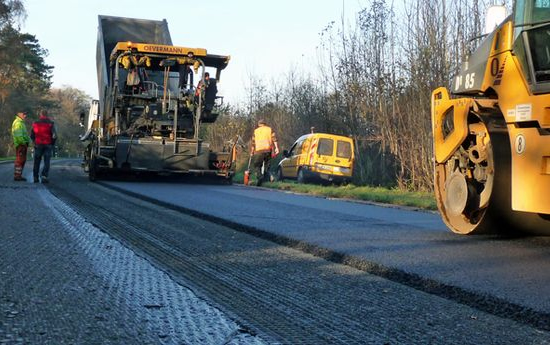By Ray Myers – The benefits of asphalt interlayers are documented going back over 40 years. Interlayers delay reflective cracking and form a moisture barrier when properly installed using liquid PG asphalt. A dry aggregate base maintains its’ designed load bearing capacity. Manufactures have continually added new and improved interlayers (paving mats, paving grids, and composite paving grids) to provide reinforcement of Hot and Warm Mix asphalts.

The use of interlayers under chip seals (Geosynthetic Reinforced Chip Seal) have been performing in excess of 30 years and to date have shown that no other pavement maintenance strategy has been able to outperform them in terms of crack reflection. Challenges can occur from the liquid blinder bleeding through the interlayer when pavement temperatures exceed about 90°F during installation.
This advisory provides options to address that bleeding and consequent vehicle tire pickup prior to or during the installation of the final wear surface.
INSTALLATION OF ASPHALT INTERLAYERS WITH HIGH TEMPS
Polymerized and neat hot oil binders are always recommended as opposed to emulsions for tack coats to be used with all interlayers that require a tack coat for installation. High viscosity binders are always preferred. If the project is to be installed where project site temperatures will be elevated hard binders are very important. If available a PG 70 binder and/or trackless tack binders will result in improved constructability. The installation of the chosen interlayer can be accomplished with a distributor truck fitted with laydown unit attached. This embeds the interlayer within very close proximity of the spreading of the hot liquid asphalt. A tractor unit with the laydown apparatus is also common and very acceptable. The latter unit provides some flexibility in that the hot binder can be allowed to minimally cool before the interlayer is embedded.

This cooling is beneficial in hot/warm mix overlays but is not desirable in a geosynthetic reinforced chip seal project.
Manufacturer’s recommendations should always be followed as to the quantity of residual asphalt binder applied for the specific interlayer being installed. PG Asphalt is preferred. Emulsions [part asphalt part water] are less appealing as the water must evaporate before the interlayer is placed. This can delay the project in nighttime or cooler weather installations. Emulsions are less viscous and can run on sloped pavements causing uneven and inadequate surface coating. The percentage of asphalt within the emulsion must be known so the quantity of residual [remaining] asphalt after water evaporation will meet specifications. Staying within the residual asphalt range recommended based on surface texture [smooth vs. coarse] of the pavement matched to the specific interlayer being installed is critical. Full saturation of the interlayer is imperative.
SEE ALSO: AIA Finish Milling Advisory on AIA website
Public traffic on the placed interlayer should be avoided whenever possible, and construction traffic should be as limited as possible. Vehicle speeds should be controlled to less than 25 mph. Sharp turning and hard stops and starts should be avoided.
Common practices used for many years to mitigate bleeding are: spraying water, broadcasting of asphaltic concrete, or spreading sand over the interlayer. The ramifications of each are listed below.
- Water sprayrequires just the right amount and at the right time. Too much leaves unwanted moisture impacting bonding of the wearing surface. Too little or too early will result in total evaporation and no benefit.
- Spreading of HMA/WMA has shortcomings in that placing uniformly is difficult. Excessive piles result in cold uncompacted product that degrade the overlying mix placement both in uniformity as well as ultimate compaction. Lastly, pick up of the HMA/WMA by traversing vehicles (construction and public) can track the loose material outside of the project limits creating additional cleanup as well as potential flying material damage to other vehicles.
- Sanding is a very good option. It has been reported from the field that sand works best especially when using fiberglass interlayers. Pavement temperatures above 90°F will soften even the hardest binders and the fiberglass products are more prone to slippage. Broadcast the sand evenly at a rate of 1-2 lb/yd2. Even if placement is uneven and piles occur they will be eliminated when sweeping (vacuum or pickup) or blowers (in rural areas) are utilized to remove the excess.The sand will be an effective bond breaker and rubber tire rolling will embed the interlayer into the hot PG liquid asphalt, thus reduce slippage and pick-up by vehicle tires. This is especially true on pavements that have been seal coated or when installing on a milled surface. Excess sand is to be removed prior to the installation of the overlay, by using vacuum pickup, sweeping (No metal bristle brooms) or blowers or kick brooms where permitted.

For additional information, visit the AIA website (www.aia-us.org), email info@aia-us.org, or call +1 800 650 2342.
Ray Myers is the Executive Director for the Asphalt Interlayer Association
RELATED: Asphalt Interlayer Association Elects HUESKER’s Samueloff New President











